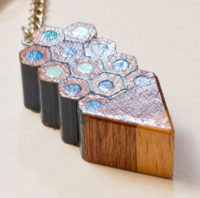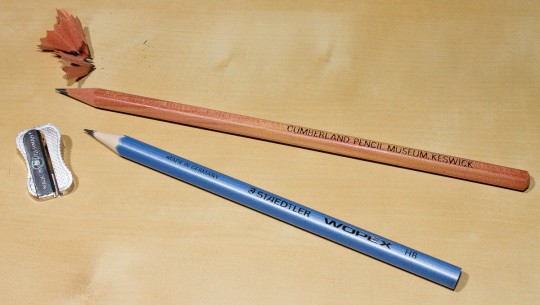Pencil Paraphernalia and a Pretty Pencil Pin Pendant
Today: pencil paraphernalia and a pretty pencil pin pendant.
My wife bought them for me last year in the Cumberland Pencil Museum shop.


If you have seen this year’s first Faber-Castell newsletter [1]If you haven’t seen it yet: You’ll also find an article about our pencil community’s own Sean, who is the man behind Contrapuntalism and The Blackwing Pages, in the newsletter. these two items might remind you of the fountain pen our favourite count [2]Usual disclaimer as mentioned previously: He is not really a count. According to Part 2, Section 1, Article 109(2) of the Weimar Constitution privileges based on birth or social status and titles of … Continue reading received for his 70th birthday: the pen’s barrel looks rather similar [3]…but is probably made from Castell 9000 pencils. Just like the Derwent pencils these two items are made in the North of England. The company behind the fridge magnet and the keyring is Zincwhite from Huddersfield [4]I certainly won’t be able to mention Huddersfield without mentioning that Professor Sir Patrick Stewart is Chancellor of the University of Huddersfield..
Nice!
References
| ↑1 | If you haven’t seen it yet: You’ll also find an article about our pencil community’s own Sean, who is the man behind Contrapuntalism and The Blackwing Pages, in the newsletter. |
|---|---|
| ↑2 | Usual disclaimer as mentioned previously: He is not really a count. According to Part 2, Section 1, Article 109(2) of the Weimar Constitution privileges based on birth or social status and titles of nobility were abolished in the Weimar Republic in 1919. Graf (Count) is just part of his surname. In reality no one seems to care about this rule though. I assume this rule hasn’t been broken in the latest book about Faber-Castell, when his wife is referred to as Gräfin (Countess), because adapting the “surname” to the gender of a person seems to be permissible. As you can see, the whole issue is rather complicated. |
| ↑3 | …but is probably made from Castell 9000 pencils |
| ↑4 | I certainly won’t be able to mention Huddersfield without mentioning that Professor Sir Patrick Stewart is Chancellor of the University of Huddersfield. |
Pencil Paraphernalia and a Pretty Pencil Pin Pendant Read More »















